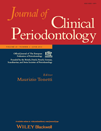Self-reported questionnaire for surveillance of periodontitis in Chinese patients from a prosthodontic clinic: a validation study
Conflict of interest and source of funding statement
The authors declare that they have no conflict of interests and have no sources of funding to disclose.
Abstract
Background and Purpose
Periodontal maintenance is critical for the long-term success of prosthodontic treatment. This study investigates the validity of questionnaires/models in monitoring periodontitis for Chinese prosthodontic patients.
Methods
In total, 114 patients completed the questionnaire. The chi-squared test and classification and regression trees were used to screen for predictive items. Predictive models developed by Yamamoto et al. and Dietrich et al. were validated using ROC curves and calibration plots.
Results
Univariate and multivariate analysis revealed that demographic features (age, gender, smoking history, education history and number of remaining teeth), symptoms(tooth mobility without injury, painful gums), dental recommendations (“need periodontal or gum treatment?”) and treatment history (scaling and root planing) were predictive of periodontitis. The AUC values of the Yamamoto model and Dietrich's model-a and model-b were 0.67, 0.89, and 0.89 for moderate/severe periodontitis and 0.78, 0.93, and 0.93 for severe periodontitis, respectively. The calibration plot showed that Dietrich's model-a and model-b accurately predicted the actual probability of moderate/severe and severe periodontitis, respectively.
Conclusion
Questionnaires may be an efficient approach to monitor periodontal health in China. Dietrich's models, with age, smoking and self-reported mobility as predictors, can be used to monitor periodontal health for Chinese prosthodontic patients.




